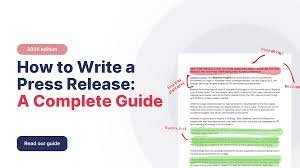A press release is one of the most effective tools for generating media coverage and spreading your message. When written properly, it can capture the attention of journalists and media outlets, leading to increased visibility and opportunities. However, with the sheer volume of press releases being sent daily, it’s crucial to craft one that stands out. In 2025, an effective press release must not only grab attention but also align with modern trends in communication, such as SEO optimization and digital media integration. This guide will walk you through how to write a press release that gets media coverage and effectively reaches your audience.
1. Craft a Compelling Headline
The headline is the first element a journalist will see, and it needs to immediately capture attention. A great headline makes the reader want to learn more, so it’s essential to make it clear, concise, and impactful.
Tips for an Engaging Headline:
-
Be Clear and Specific: Avoid vague or overly complex language. Your headline should immediately convey what your announcement is about.
-
Incorporate Action: Use action verbs to make your headline more dynamic and attention-grabbing.
-
Keep It Short: Aim for no more than 70 characters to ensure it displays well across various devices and media platforms.
-
Add a Hook: Include an angle or unique aspect of your story that makes it stand out.
Example: “XYZ Corp Launches Revolutionary AI Tool for Healthcare in 2025”
Why It’s Important:
-
First Impressions Matter: The headline is the first thing journalists see. A compelling headline ensures they’ll want to continue reading.
-
SEO: A well-crafted headline that includes relevant keywords can boost your press release’s visibility in search engines, helping it gain more traction.
2. Start with a Strong Lead Paragraph
The lead paragraph, also known as the lede, is crucial in answering the five Ws—Who, What, When, Where, and Why. It should present the most important information right away and entice the reader to continue reading.
Key Elements of the Lead Paragraph:
-
Answer the 5 Ws: Your lead should immediately answer who is involved, what’s happening, when it’s happening, where it’s taking place, and why it matters.
-
Keep It Brief: The lead should be concise, usually one or two sentences, providing a snapshot of the news.
-
Provide Context: Highlight the significance of the news to help the reader understand why it’s important.
Example: “XYZ Corp, a leader in AI solutions, has launched a groundbreaking AI-powered tool designed to revolutionize healthcare diagnostics. Available worldwide starting March 2025, the tool promises to enhance patient outcomes and reduce diagnostic errors.”
Why It’s Important:
-
Immediate Clarity: The lead sets the stage for the rest of the press release, making it easy for journalists to quickly assess whether they want to cover the story.
-
SEO: Including relevant keywords in the lead paragraph helps optimize your press release for search engines, increasing the likelihood of it being discovered online.
3. Provide Relevant Details and Background Information
After the lead, the body of the press release should elaborate on the story with further details, context, and background. This section is where you can expand on the “who,” “what,” “when,” and “why,” providing additional facts and quotes.
What to Include:
-
Key Quotes: Include quotes from key stakeholders like company executives or industry experts. Quotes add credibility and humanize the press release, making it more relatable.
-
Statistics and Data: Use relevant statistics, studies, or data points to substantiate your claims and demonstrate the significance of your announcement.
-
Context and History: Provide background information on your company or the event being announced to give readers a full understanding of the topic.
Example: “’This new AI tool is a game-changer for the healthcare industry,’ said John Doe, CEO of XYZ Corp. ‘By reducing diagnostic errors, we can save lives and reduce healthcare costs globally.’ According to a recent study, diagnostic errors account for nearly 10% of patient deaths in the United States.”
Why It’s Important:
-
Depth and Insight: Offering more details ensures that journalists have the information they need to create a full story.
-
Credibility: Well-placed quotes and data points back up your claims, making your press release more credible and authoritative.
4. Include a Call to Action (CTA)
Every press release should have a clear call to action, guiding readers or journalists on what to do next. Whether it’s visiting your website, attending an event, or contacting you for more details, the CTA should be direct and easy to follow.
How to Write a Strong CTA:
-
Be Direct: Tell the reader exactly what you want them to do. For example, “For more information, visit [website link]” or “Contact [contact person] for interview opportunities.”
-
Keep It Simple: Your CTA should be easy to act on, such as clicking a link, making a call, or sending an email.
Example: “For additional information on the new AI tool, visit [website link] or contact our PR team at [email address].”
Why It’s Important:
-
Encourages Action: A clear CTA guides journalists and readers on what to do next, whether that’s covering your story or taking an action that furthers your goal.
-
Helps You Measure Success: A CTA enables you to track the effectiveness of your press release by monitoring clicks, sign-ups, or other interactions.
5. End with a Boilerplate About Your Company
The boilerplate is a brief paragraph at the end of your press release that provides essential information about your company. It gives context to who you are, what you do, and why your news matters.
What to Include in the Boilerplate:
-
Company Overview: Briefly describe your company’s mission, products, and services.
-
Key Achievements: Highlight any notable accomplishments, industry recognition, or awards.
-
Contact Information: Include relevant contact information for media inquiries.
Example: “XYZ Corp is a leading provider of AI-powered solutions that help industries improve efficiency and reduce operational costs. Founded in 2015, the company has revolutionized sectors such as healthcare, finance, and logistics. For media inquiries, contact [email address].”
Why It’s Important:
-
Clear Company Info: A boilerplate provides essential context for journalists, giving them a quick overview of your company and its relevance to the press release.
-
Contact Details: Including contact information ensures that journalists can easily follow up with you for more details.
6. Optimize for SEO
To ensure your press release gets maximum exposure, it’s essential to optimize it for search engines. SEO-optimized press releases are more likely to be picked up by media outlets and rank well in search results.
SEO Best Practices:
-
Keyword Research: Identify relevant keywords that your target audience is searching for and incorporate them into your headline, body, and CTA.
-
Use Internal Links: If relevant, link to your website or other blog posts to drive traffic back to your site.
-
Optimize Metadata: Include relevant keywords in your press release’s meta title and description to help it rank on search engines.
Why It’s Important:
-
Increased Visibility: Optimizing your press release for SEO ensures that it reaches a wider audience by improving its ranking on search engines.
-
Higher Media Pick-Up: A well-optimized press release is more likely to be discovered by journalists, resulting in more coverage.
7. Proofread and Edit for Clarity
The final step in writing a powerful press release is proofreading. A well-written press release is free of errors and flows smoothly. Journalists are more likely to use your press release if it’s professional and easy to read.
Proofreading Tips:
-
Check for Spelling and Grammar Errors: Small mistakes can undermine your credibility. Use tools like Grammarly or have someone else proofread your press release.
-
Ensure Clarity: Make sure the press release is clear, concise, and free of jargon. The goal is for journalists to quickly understand the news.
-
Check Formatting: Ensure the press release is well-organized with proper formatting (e.g., bold headlines, clear sections).
Why It’s Important:
-
Professionalism: A press release with errors or unclear messaging reflects poorly on your brand and reduces the likelihood of media coverage.
-
Easy Reading: Journalists need to absorb information quickly. A clean, error-free release is more likely to be used.
Conclusion: Writing a Press Release That Gets Results
Writing a powerful press release that gets media coverage in 2025 requires a blend of journalistic skill, SEO knowledge, and a deep understanding of your audience. By crafting an engaging headline, providing valuable details, including a call to action, and optimizing for search engines, you can ensure your press release reaches the right people. Avoiding common pitfalls and maintaining professionalism throughout will increase your chances of getting media coverage, expanding your reach, and boosting your brand’s visibility. With these strategies, your press releases will stand out and achieve the attention they deserve.

